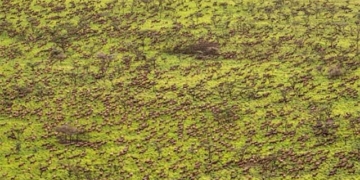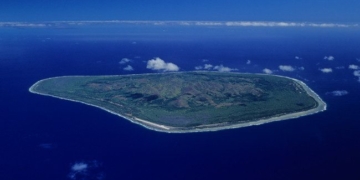The Falcon Lake UFO incident is a notable sighting of an unidentified flying object (UFO) that occurred in 1967 at Falcon Lake, located in Whiteshell Provincial Park in Manitoba, Canada.
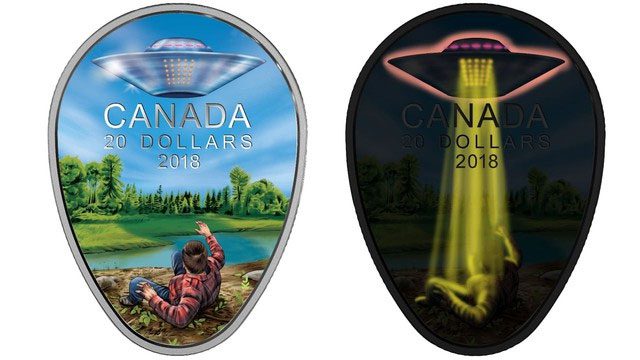
Coin issued to commemorate the 50th anniversary of the Falcon Lake UFO incident in Canada.
The oval-shaped coin displayed above is a commemorative piece released by the Royal Canadian Mint in 2018. It resembles a drop-shaped coin, featuring an engraving of a man falling to the ground, his arms raised as if trying to shield himself from a UFO hovering above him. When you turn off the lights and shine ultraviolet light on the coin, you can also see a beam of greenish-yellow light emanating from beneath the flying saucer, as if it is attempting to abduct the man below.
While many might view this commemorative coin as an oddity designed by the mint’s product department with the obvious goal of high sales, the reality is much more profound. This unique coin not only has a special shape but also a remarkable backstory; it was issued to commemorate the 50th anniversary of the Falcon Lake UFO incident in Canada.
Chris Rutkovsky, a Canadian expert in the field of the paranormal, believes that the impact of the Falcon Lake UFO incident in Canada surpasses even the Roswell incident of 1947. So what exactly happened to the man on the coin over 50 years ago?
The man with his arm raised on the coin is named Stephen Michalak. After World War II, he immigrated to Canada with his family from Poland. One day in May 1967, Stephen set off from Winnipeg, Manitoba, to a mountainous area called Falcon Lake in search of quartz and silver. However, this journey would change the rest of his life.
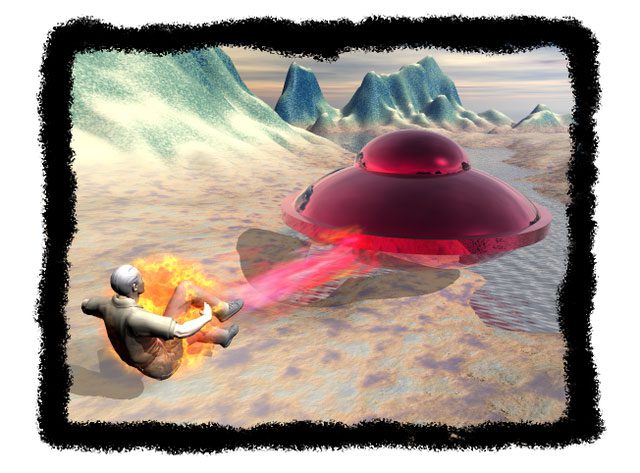
In the 1960s and 1970s, many wilderness areas were unregulated, and the remote location of Falcon Lake was very desolate, often only inhabited by wild birds. When Stephen arrived at Falcon Lake, he suddenly noticed a flock of birds flying in one direction as if frightened by something.
Confused, Stephen instinctively looked in the opposite direction of the birds to see what was happening. He was startled to see two disc-shaped aircraft hovering in the air, glowing red and slowly decelerating. Suddenly, one of them stopped in mid-air while the other approached closer, landing in an open area not far from him.
At this moment, Stephen was drawn to the landed flying saucer. He hid behind a rock and took the time to sketch the features of the craft.
The sketch reveals that the diameter of the UFO was approximately 12 meters and its height about 3 meters. However, as Stephen completed his sketch, he suddenly felt a warm stream in the air moving towards him along with a sulfur-like smell. Curiosity compelled Stephen to approach the UFO closer.

Drawing of the UFO based on Stephen’s description.
On May 24, 1967, the Royal Canadian Mounted Police documented a detailed account of Stephen’s encounter with the UFO. According to the recorded description, as Stephen approached the saucer, the warm air and sulfuric smell intensified, and he could hear a buzzing sound resembling wind, as if the craft’s engine was sucking in the air.
At that moment, Stephen saw a door open beside the craft, with blinding light emanating from inside. Out of curiosity, he stepped closer and called out, saying if there were Americans inside, they should come out and not be afraid, offering his assistance. However, there was no response from within. Stephen then attempted to communicate in Russian, but still received no answer. He subsequently asked questions in German, Italian, French, and Ukrainian, yet there was still no reply.
Determined to look inside the UFO, Stephen moved even closer, but he could see no one or anything inside except for various lights and beams. Just as he was about to leave, the hatch of the UFO suddenly closed perfectly, leaving no trace of a door. Curiously, Stephen touched the surface of the craft, and upon contact, his hand felt as if it were burning; even his gloves caught fire, prompting him to quickly retract his hand.
What baffled Stephen was that he was standing next to the UFO without feeling high temperatures, yet the surface of the craft burned his gloves and left burns on his palm. Moments later, the UFO began rotating counterclockwise. Just as Stephen was preparing to advance further, a powerful blast of air suddenly expelled from the craft, pushing him away and igniting his clothing. The UFO quickly ascended and vanished without a trace.
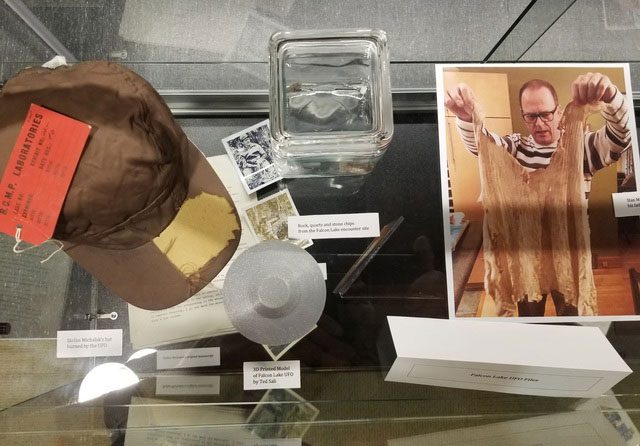
Stephen’s clothing preserved in the archives of the University of Manitoba, Canada.
At this point, he picked up his compass and found the needle spinning erratically before it gradually stabilized after a few minutes.
When everything was over, Stephen even thought he had dreamt or hallucinated the experience, but the severe headache and nausea brought him back to reality; this was indeed not a dream but a real experience. When Stephen returned to his hotel, he felt unbearable pain in his chest, and upon bending down, he discovered severe burns on his chest.
Realizing that he could only be saved by leaving the area, Stephen left the hotel, opened his compass, and drove off with great difficulty. After driving for a while, he was spotted by RCMP officer Solotky on patrol, who initially thought Stephen was intoxicated. However, upon closer inspection, he realized Stephen showed no signs of having consumed alcohol.
Stephen recounted precisely what had happened to him, but the police did not believe him and informed him that they had other matters to attend to before leaving. After descending the mountain, Stephen was taken to a hospital in Winnipeg, where he was examined and treated for burns on his upper abdomen.
From the photograph taken at that time, it is evident that Stephen had distinct burn marks resembling a grid pattern on his chest and abdomen, and his vest also showed signs of burning. The doctors could not determine the cause of the burns on Stephen’s body and ultimately classified them as chemical burns.
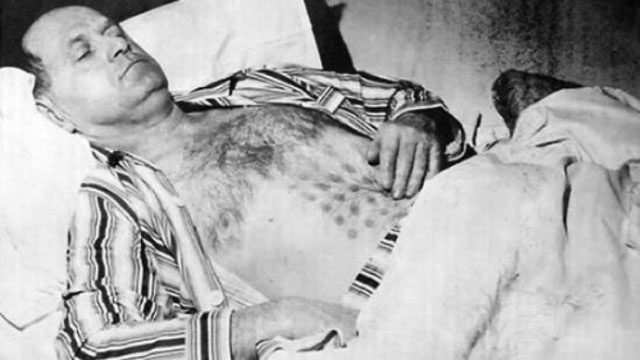
Stephen Michalak and the burns on his body.
After being discharged from the hospital, Stephen, the UFO encounter survivor, consistently experienced unusual smells, diarrhea, severe headaches, fainting, and continuous weight loss, which severely impacted his normal life. Consequently, Stephen sought help from the Mayo Clinic in Minnesota and even consulted a psychiatrist, but the results mirrored his initial hospitalization with no progress.
Diagnostic reports from various hospitals indicated that starting from May 1967, Stephen’s symptoms of redness and itching on his chest and legs persisted, with flare-ups occurring approximately every 110 days. Beginning in January 1968, the recurrences became more frequent, but the duration of the symptoms started to shorten. Doctors tried various medications, but none showed significant effects.
The doctors believed that Stephen’s symptoms resembled radiation poisoning, yet numerous tests indicated he had not been exposed to harmful levels of radiation. However, his lymphocyte count had dropped to dangerously low levels. Reports from the psychiatrist showed that Stephen was a very pragmatic individual, suggesting he was not fabricating his story.
Ultimately, the clothing, gloves, and some items Stephen wore during the incident were preserved in the archives of the University of Manitoba, Canada, but the story did not end there.
Immediately following the incident, several agencies in Canada and the United States began investigating Stephen’s claims. Subsequently, some experts suggested that the reason for the public’s interest in this matter was due to several significant factors.
First is the reliability of the witness. Having experienced the entire event, Stephen was assessed by a psychiatrist as a trustworthy individual. He had no history of fabricating sensational events or seeking attention, making his claims even more persuasive. Additionally, Stephen never exaggerated; even before the incident, he was an atheist, skeptical of the existence of extraterrestrials.
Second, Stephen provided a very detailed account of the incident, including the shape, texture, and intense heat of the UFO, as well as the burned gloves and clothing. These consistent details led many to believe that his experience was genuine.
Finally, there is physical evidence that Stephen could provide, which supports his claims. His body showed clear signs of burns, which completely aligns with his description that the spacecraft emitted high-temperature gases and knocked him away. The most undeniable fact is that the landing site of the flying saucer had clearly burned the vegetation, which has become one of the crucial pieces of evidence in the entire incident.
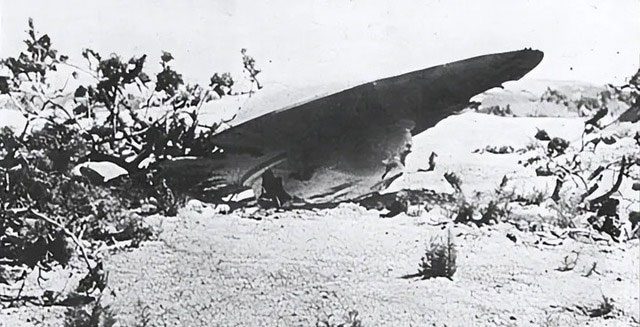
After the UFO incident at Falcon Lake, several other people reported seeing a red butterfly-shaped UFO.
Investigators also did their utmost to provide the public with a conventional explanation for the incident, suggesting it could have been an aircraft or military vehicle that Stephen encountered that day. However, no one could explain all the details and physical evidence in the investigative report.
Subsequently, according to local police records, about a week after the incident at Falcon Lake, several other residents in Manitoba reported seeing a red butterfly-shaped UFO as well. And in the following years, more sightings continued to be revealed.
Although Stephen provided relatively comprehensive evidence regarding the Falcon Lake incident, some people remained skeptical about UFOs. They offered various explanations for the incident, with some suggesting that the entire event was merely a hoax or fabrication designed to distract public attention for some reason. The vast majority of skeptics believe that Stephen actually did this to garner attention and gain financial benefits. However, this explanation fails to account for the physical evidence or explain why Stephen subsequently did not appear before the public and seemingly avoided public attention.
Some skeptics believe that perhaps Stephen encountered some natural phenomenon, such as a discharge or a rare atmospheric occurrence. Ultimately, some suggest that Stephen might have had psychological issues, hallucinations, or delusions. Nonetheless, it is undeniable that until his death in 1999, the scars left from the day he encountered the flying saucer remained unchanged. The Falcon Lake incident is perplexing because, unlike many other UFO incidents, it is very difficult to completely dismiss. Moreover, Stephen himself appears to be a credible witness.

















































